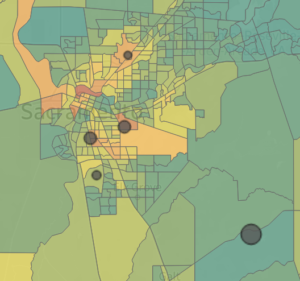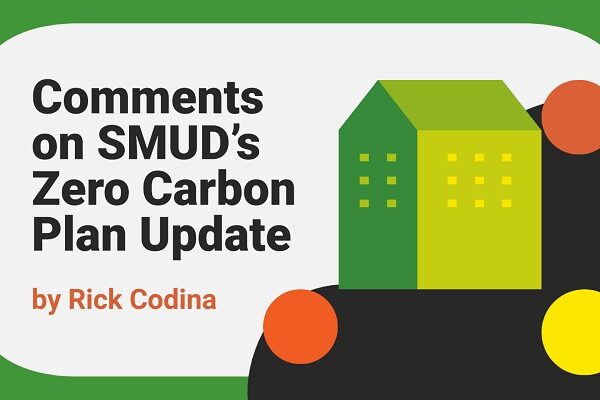by David Wright
For many Sacramentans, it may come as a shock that our local utility – the Sacramento Municipal Utility District (SMUD) – is moving away from supporting rooftop solar. In the past SMUD has been an environmental leader, and you can hardly go two miles in the city without seeing a large billboard touting how “green” SMUD is. Scratch the surface, however, and you will find that SMUD is opting for business income over environmental and customer benefits, and clinging to dirty fossil fuels.
I’ve been attending many SMUD Board of Directors meetings and Board Committee meetings in the past year, and I sat on a Technical Working Group convened by SMUD, on behalf of 350Sacramento.org. This blog entry is based on some of what I have learned.
SMUD has no plans to close their five fossil fuel power plants.

Location of the power plants, taken from https://www.psehealthyenergy.org/california-power-map/
Sacramento has some of the highest levels of toxic air pollutants in the United States – yes, to a great extent due to car and truck traffic, but SMUD’s gas-fired plants aggravate significant air quality concerns in communities that already suffer from pollution and poverty, such as Coin Estates, Colonial Village and North Highlands. Despite this, SMUD has no plans to shut these dirty plants down.
Combined, SMUD’s five fossil fuel plants emit approximately 2,500,000 tons of carbon dioxide a year. SMUD does plan to reduce their use – but only to 1,000,000 tons of carbon dioxide per year and only by the year 2040. While the City of Sacramento has acknowledged a Climate Emergency and resolved to achieve zero carbon emissions by 2030, SMUD Board members have indicated to me no stomach for such an ambitious, important goal.
SMUD is making it harder for their customers to go solar.
Over the past year, SMUD has repeatedly sought to limit the growth of solar in Sacramento. In the spring of 2019, SMUD proposed new fees that would have prevented, in practical terms, families and businesses from investing in solar. For the average residential customer, SMUD’s proposal would have increased the cost of rooftop solar typically by more than $400 per year. Rooftop solar just cannot pencil out with such an unfair burden. Commercial solar customers would have paid twice the residental rate per unit of energy they generated..
Thanks to overwhelming public opposition and protest, SMUD’s proposed fees on solar were beaten back. But SMUD has not abandoned the idea of charging rooftop solar customers more – they are commissioning a “Value of Solar” study to support a new rooftop solar billing rate. This is an issue to watch very closely in the coming year, and we will.
SMUD continues to try to shift solar away from customer rooftops in other ways. In the fall of 2019, SMUD staff put forward a proposal they called Neighborhood Solar Shares that would allow them to skirt California’s landmark new solar homes mandate. California’s new building standard requires all new homes and low-rise apartments to have solar. The default is rooftop solar, but the rule provides an option for “community solar” projects, which is not well defined. SMUD’s program sets an aggressive precedent that undermines the new solar home initiative.
Under the “Neighborhood Solar Shares” program, SMUD would:
- Encourage developers to choose participation in the SolarShares program – at zero developer cost! – rather than install rooftop solar
- Resell energy from solar farms to these residences, with customer savings of about $2.50 per month – yet SMUD’s customers would save about $6.50 a month with their own rooftop solar even accounting for the mortgage cost of the system
- Make it financially prohibitive for customers once in their program to install solar on their own roofs for 20 years
- Remove incentives for battery storage, which is key for clean energy development, supplying power to the grid at night and during cloudy periods, and for customer backup power.
What difference does it make if the solar is on the roof or from a solar farm? Several reasons: the extra financial benefit to the customer is lost, the battery storage benefit is lost, potentially open space and wildlife habitat is lost, and transmission costs and losses are increased. Ultimately, we need both well-placed solar farms and rooftop solar, yet SMUD’s program blocks the rooftops, and for 20 years. We don’t have that time.
A tarnished dream
SMUD’s approach to the Neighborhood Solar Shares proposal has strained the community’s trust in the utility that is supposed to “belong” to us. The proposal was never brought before the SMUD Board of Directors for public review and comment, but was quietly submitted to the California Energy Commission (CEC) by SMUD staff. Even when customers and environmental and solar advocates learned of the proposal and there was substantial outrage and public comment, even after the CEC therefore tabled the issue when it first came up for a vote in November, even after explicit requests from customers and advocates, SMUD resubmitted its proposal but refused a public airing, even cancelling a scheduled Board Committee meeting on the topic. Regrettably, the CEC approved SMUD’s Neighborhood Solar Shares proposal on February 20th.
Plenty to do.
SMUD clearly has not yet fully processed the gravity of the climate crisis or the depth of responsibility we/they have to act. We must be committed to helping them achieve this. I believe they are only just beginning to realize the breadth and power of feeling that is rising among their citizens. The climate crisis demands and we plead that SMUD do better. In another discussion recently with a SMUD Board member, 350Sac was painted as never being satisfied, so why should the Board even listen? Tell SMUD: we have a clear goal – it’s in our name: 350 ppm atmospheric CO2. Rather than undermining landmark solar policy in California and polluting the planet for another 20 years and more, SMUD should commit to shuttering their power plants and fully embrace clean energy. Here are some ways to take action:
- Wed Mar 4 at 6 PM
- 350 Sacramento Panel on SMUD – A 350 event where you can learn more about what’s going on with SMUD and discuss next steps. See 350Sacramento.org for location and more info.
- The Solar Rights Alliance has some accessible, useful information about SMUD (click here, then click on the “Tell SMUD: Clean Power for the People” banner), and some ways to send your input to SMUD: Sign a petition to SMUD here
- Mar 18, 5:30 PM, 6201 S Street
- SMUD Board Committee meeting on ‘Everything Solar.’ Come let them know you want less greenhouse gases and more solar – and input on their next General Manager (hiring process now underway).



Comments(2)
Anonymous says:
March 5, 2020 at 1:18 amIMHO, this is a complex issue with a few angles. First, the American economy depends on reliable electricity supply. We can’t un-assume that fact. SMUD isn’t prepared to deliver sufficient flow to Sacramentans during peak periods without its n/g power plants. And those plants are producing less emissions than you might think, partly because they use some of the most efficient tech available, and in part because they only operate under peak demand.
Second, rooftop solar has it’s own issues. It doesn’t scale well. It’s at odds with urban planners’ goals for high-density built environment and urban forest canopy. Rooftops can’t be optimally oriented toward the sun. And the average cost of ownership is higher than community or utility-scale solar. That cost is borne by homeowners. Solar farms, on the other hand, place generation in an optimized location and often use follow-the-sun dynamic drives for efficiency improvements.
There are cases for rooftop solar, especially in commercial/industrial applications. But I don’t think it’s preferable in all cases to large-scale renewable. Planting solar on every rooftop will really get people fired up… literally.
Roger Blackwell phone (916) 682-9530 says:
April 8, 2023 at 3:10 pmSMUD is in BED with D.E. Shaw to have Shaw to build a 400 MW solar farm at Rancho Saco. Then buy the electric back form Shaw. How much of a kick back does the board of dictator receive form D.E. Shaw. This is why SMUD is stopping rooftop solar in Sacramento. Every one who is on SMUD power grid pay a service charge of $23.50 per month at a 1,500,000 meters comes to $35,250,000 in service charges Per mouth alone. The SMUD board of dictator answer to no one. They run to their BANK on the back of the rate payers.